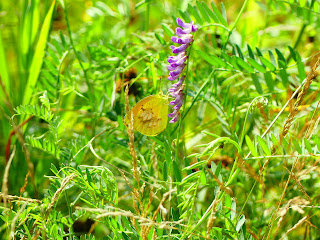Butterfly Count
Here's a Sleepy Orange Butterfly I saw as a part of the basically-annual Duke Farms butterfly count. This is a day when some local lepidopterists, some Duke Farms staff, and some Duke Farms volunteers (I'm in this last category) gather at Duke Farms to count butterflies.
Generally we split up into 2-3 groups to cover different areas of the property, count the butterflies we're able to identify (sometimes they fly off before we can tell what the butterfly was), and then the results get combined into a report. The butterflies are not collected or even caught - this is a purely observational event.
The Sleepy Orange is one of the more interesting stories to come out of the butterfly count. Two years ago the lepidopterists were excited to see a Sleepy Orange Butterfly, and then another one, and then another one. After they got to maybe a dozen of them, they were not as excited by seeing them, though the big story was that it wasn't known that Sleepy Oranges were in Somerset County at all, and now they were actually abundant, at least at parts of Duke Farms.
When I heard this, I was a little surprised since I thought I had photographed them here a couple years earlier. Afterwards I emailed the lead lepidopterist with a single individual and a pair from 2017, and his consensus was that these were the earliest known sightings of this butterfly in Somerset County.
I had no idea when I took the pictures or posted them to iNaturalist that they were unknown in the county; I just knew they were a little different than the more common sulphurs in the area.
By 2020, when we had a smaller pandemic butterfly count, we confirmed that there seems to be a thriving community of Sleepy Orange Butterflies that have colonized parts of Duke Farms. In 2 years they've gone from being virtually unknown there to now being routinely seen.
It's unclear what this means. My field guide (a few years old) implies that the Sleepy Orange is a more southern species that can be spotted in NJ as "a stray", but it seems like we've got a population living here now. Is this a sign of climate change, that generally warmer weather is making this area more amenable to these butterflies? Are they going to out-compete the other sulphur butterflies that have traditionally been here? And so far I haven't seen Sleepy Oranges in the county outside of Duke Farms; why is that? I'm not sure anyone really knows these answers, but butterfly counts like this help us realize that our environment is changing.
 |
| July 25 during Duke Farms Butterfly Count |



Comments
Post a Comment